Organisational Behaviour Report: A David & Co Ltd - Key Factors
VerifiedAdded on 2020/10/22
|16
|4889
|177
Report
AI Summary
This report on organisational behaviour analyzes the influence of culture, power, and politics on individuals and teams within A David & Co Limited. It explores various organisational cultures, including power, role, task, and person cultures, and examines the different types of power, such as legitimate, expert, referent, and coercive power. The report further delves into motivational theories, including content and process theories, with a focus on Maslow's hierarchy of needs and Vroom's expectancy theory. It also covers financial and non-financial motivational techniques. The report concludes with a discussion on different types of effective teams, including functional, problem-solving, cross-functional, and self-managed teams, and the factors that contribute to their success. The report provides a comprehensive overview of the key elements of organisational behaviour and their practical implications for leadership and management within the context of the case study of A David & Co Limited.
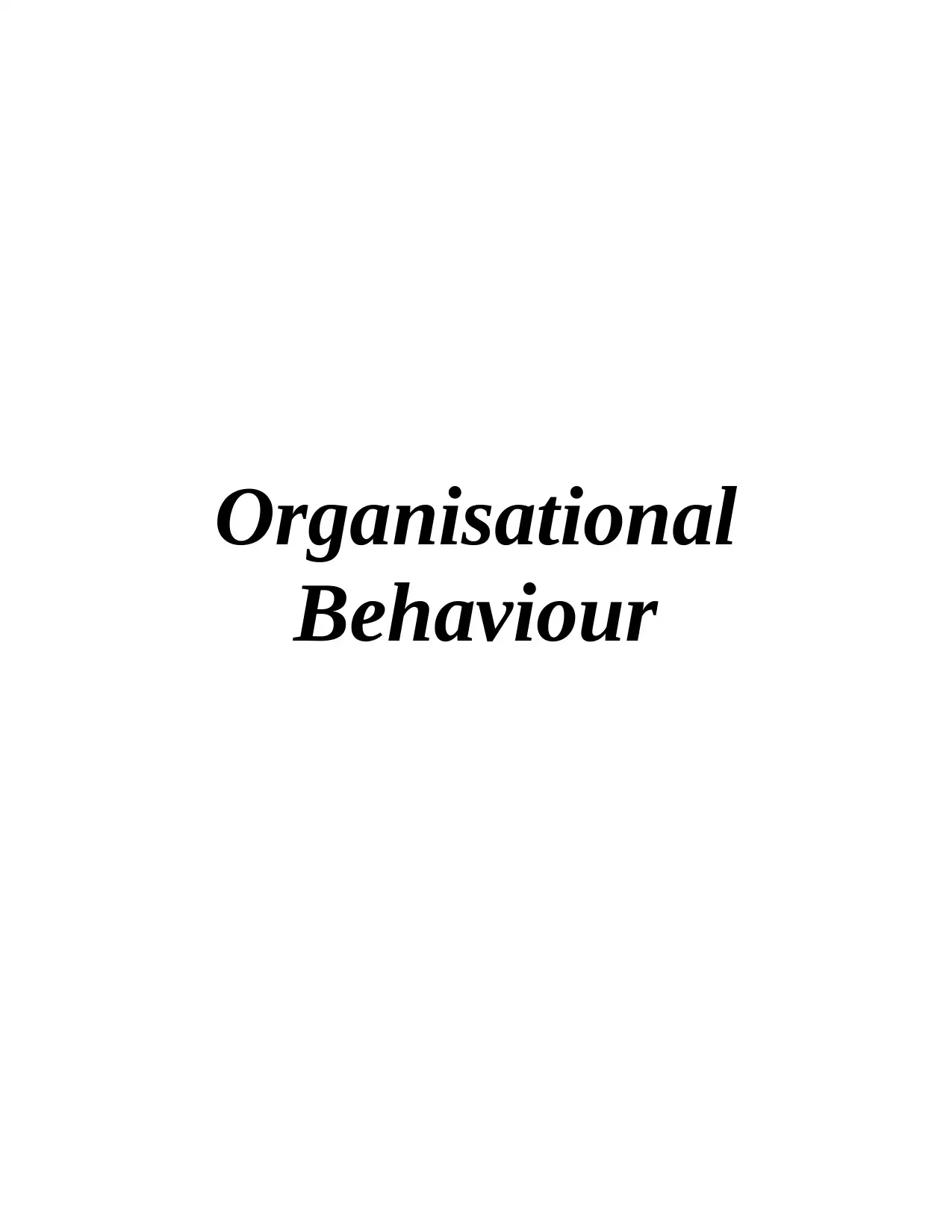
Organisational
Behaviour
Behaviour
Paraphrase This Document
Need a fresh take? Get an instant paraphrase of this document with our AI Paraphraser
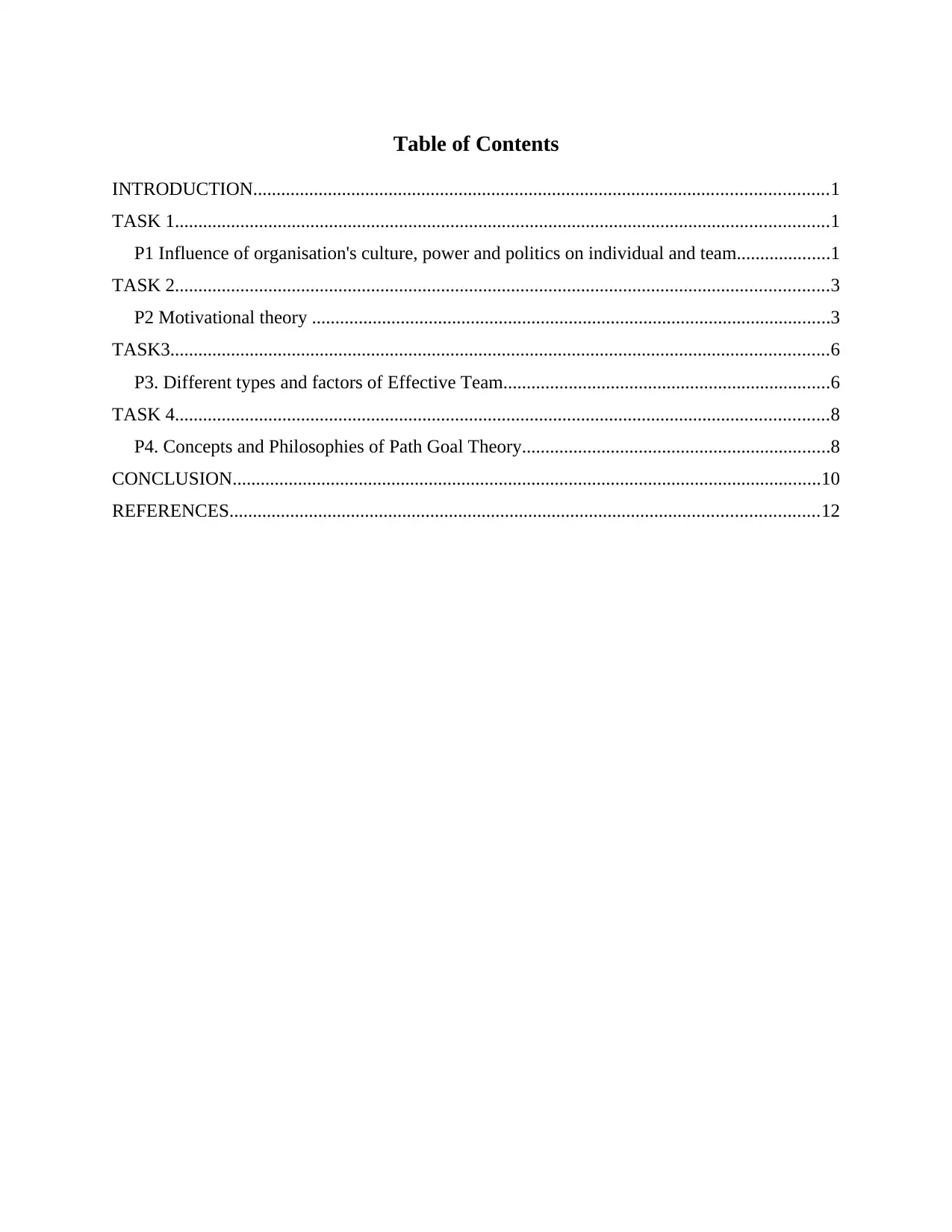
Table of Contents
INTRODUCTION...........................................................................................................................1
TASK 1............................................................................................................................................1
P1 Influence of organisation's culture, power and politics on individual and team....................1
TASK 2............................................................................................................................................3
P2 Motivational theory ...............................................................................................................3
TASK3.............................................................................................................................................6
P3. Different types and factors of Effective Team......................................................................6
TASK 4............................................................................................................................................8
P4. Concepts and Philosophies of Path Goal Theory..................................................................8
CONCLUSION..............................................................................................................................10
REFERENCES..............................................................................................................................12
INTRODUCTION...........................................................................................................................1
TASK 1............................................................................................................................................1
P1 Influence of organisation's culture, power and politics on individual and team....................1
TASK 2............................................................................................................................................3
P2 Motivational theory ...............................................................................................................3
TASK3.............................................................................................................................................6
P3. Different types and factors of Effective Team......................................................................6
TASK 4............................................................................................................................................8
P4. Concepts and Philosophies of Path Goal Theory..................................................................8
CONCLUSION..............................................................................................................................10
REFERENCES..............................................................................................................................12

⊘ This is a preview!⊘
Do you want full access?
Subscribe today to unlock all pages.

Trusted by 1+ million students worldwide
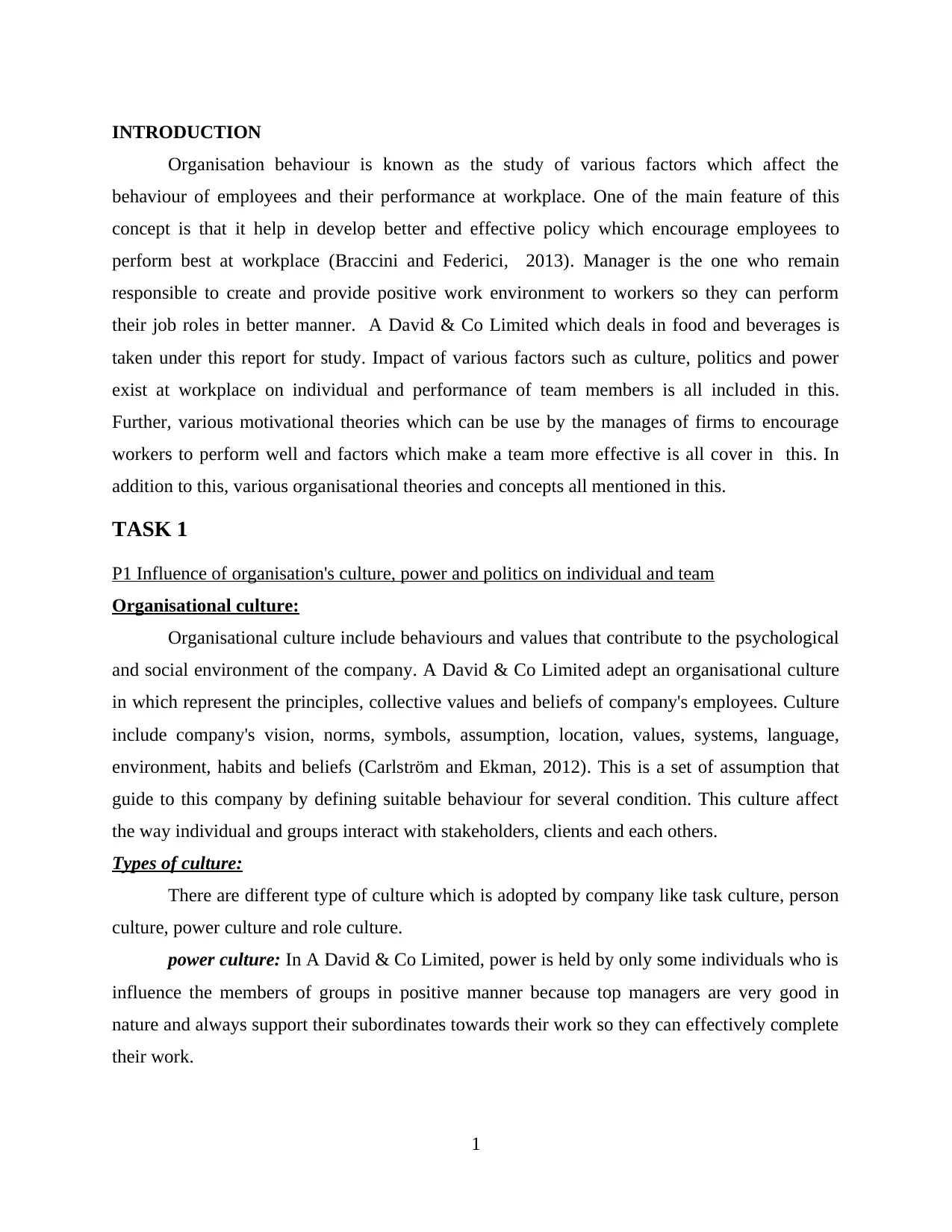
INTRODUCTION
Organisation behaviour is known as the study of various factors which affect the
behaviour of employees and their performance at workplace. One of the main feature of this
concept is that it help in develop better and effective policy which encourage employees to
perform best at workplace (Braccini and Federici, 2013). Manager is the one who remain
responsible to create and provide positive work environment to workers so they can perform
their job roles in better manner. A David & Co Limited which deals in food and beverages is
taken under this report for study. Impact of various factors such as culture, politics and power
exist at workplace on individual and performance of team members is all included in this.
Further, various motivational theories which can be use by the manages of firms to encourage
workers to perform well and factors which make a team more effective is all cover in this. In
addition to this, various organisational theories and concepts all mentioned in this.
TASK 1
P1 Influence of organisation's culture, power and politics on individual and team
Organisational culture:
Organisational culture include behaviours and values that contribute to the psychological
and social environment of the company. A David & Co Limited adept an organisational culture
in which represent the principles, collective values and beliefs of company's employees. Culture
include company's vision, norms, symbols, assumption, location, values, systems, language,
environment, habits and beliefs (Carlström and Ekman, 2012). This is a set of assumption that
guide to this company by defining suitable behaviour for several condition. This culture affect
the way individual and groups interact with stakeholders, clients and each others.
Types of culture:
There are different type of culture which is adopted by company like task culture, person
culture, power culture and role culture.
power culture: In A David & Co Limited, power is held by only some individuals who is
influence the members of groups in positive manner because top managers are very good in
nature and always support their subordinates towards their work so they can effectively complete
their work.
1
Organisation behaviour is known as the study of various factors which affect the
behaviour of employees and their performance at workplace. One of the main feature of this
concept is that it help in develop better and effective policy which encourage employees to
perform best at workplace (Braccini and Federici, 2013). Manager is the one who remain
responsible to create and provide positive work environment to workers so they can perform
their job roles in better manner. A David & Co Limited which deals in food and beverages is
taken under this report for study. Impact of various factors such as culture, politics and power
exist at workplace on individual and performance of team members is all included in this.
Further, various motivational theories which can be use by the manages of firms to encourage
workers to perform well and factors which make a team more effective is all cover in this. In
addition to this, various organisational theories and concepts all mentioned in this.
TASK 1
P1 Influence of organisation's culture, power and politics on individual and team
Organisational culture:
Organisational culture include behaviours and values that contribute to the psychological
and social environment of the company. A David & Co Limited adept an organisational culture
in which represent the principles, collective values and beliefs of company's employees. Culture
include company's vision, norms, symbols, assumption, location, values, systems, language,
environment, habits and beliefs (Carlström and Ekman, 2012). This is a set of assumption that
guide to this company by defining suitable behaviour for several condition. This culture affect
the way individual and groups interact with stakeholders, clients and each others.
Types of culture:
There are different type of culture which is adopted by company like task culture, person
culture, power culture and role culture.
power culture: In A David & Co Limited, power is held by only some individuals who is
influence the members of groups in positive manner because top managers are very good in
nature and always support their subordinates towards their work so they can effectively complete
their work.
1
Paraphrase This Document
Need a fresh take? Get an instant paraphrase of this document with our AI Paraphraser
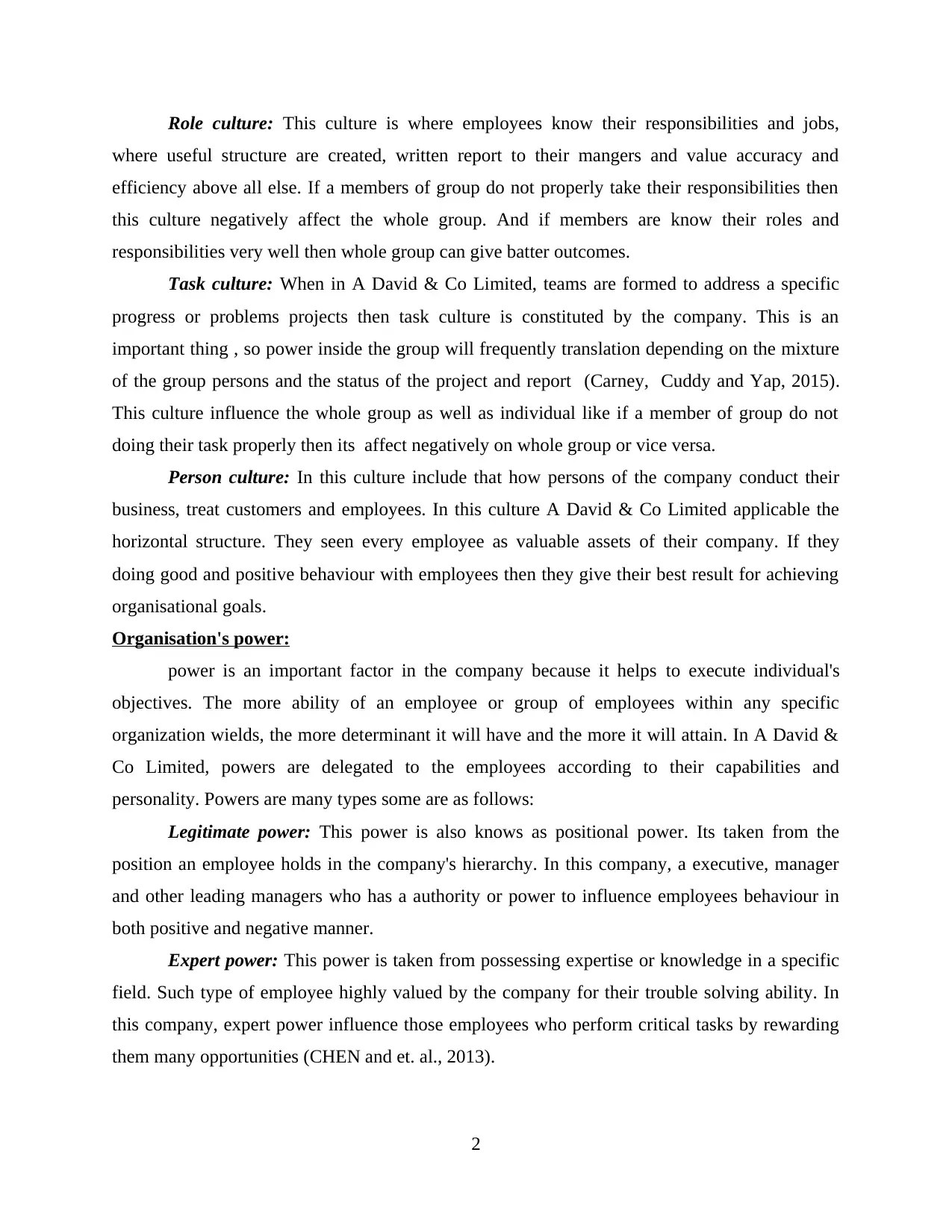
Role culture: This culture is where employees know their responsibilities and jobs,
where useful structure are created, written report to their mangers and value accuracy and
efficiency above all else. If a members of group do not properly take their responsibilities then
this culture negatively affect the whole group. And if members are know their roles and
responsibilities very well then whole group can give batter outcomes.
Task culture: When in A David & Co Limited, teams are formed to address a specific
progress or problems projects then task culture is constituted by the company. This is an
important thing , so power inside the group will frequently translation depending on the mixture
of the group persons and the status of the project and report (Carney, Cuddy and Yap, 2015).
This culture influence the whole group as well as individual like if a member of group do not
doing their task properly then its affect negatively on whole group or vice versa.
Person culture: In this culture include that how persons of the company conduct their
business, treat customers and employees. In this culture A David & Co Limited applicable the
horizontal structure. They seen every employee as valuable assets of their company. If they
doing good and positive behaviour with employees then they give their best result for achieving
organisational goals.
Organisation's power:
power is an important factor in the company because it helps to execute individual's
objectives. The more ability of an employee or group of employees within any specific
organization wields, the more determinant it will have and the more it will attain. In A David &
Co Limited, powers are delegated to the employees according to their capabilities and
personality. Powers are many types some are as follows:
Legitimate power: This power is also knows as positional power. Its taken from the
position an employee holds in the company's hierarchy. In this company, a executive, manager
and other leading managers who has a authority or power to influence employees behaviour in
both positive and negative manner.
Expert power: This power is taken from possessing expertise or knowledge in a specific
field. Such type of employee highly valued by the company for their trouble solving ability. In
this company, expert power influence those employees who perform critical tasks by rewarding
them many opportunities (CHEN and et. al., 2013).
2
where useful structure are created, written report to their mangers and value accuracy and
efficiency above all else. If a members of group do not properly take their responsibilities then
this culture negatively affect the whole group. And if members are know their roles and
responsibilities very well then whole group can give batter outcomes.
Task culture: When in A David & Co Limited, teams are formed to address a specific
progress or problems projects then task culture is constituted by the company. This is an
important thing , so power inside the group will frequently translation depending on the mixture
of the group persons and the status of the project and report (Carney, Cuddy and Yap, 2015).
This culture influence the whole group as well as individual like if a member of group do not
doing their task properly then its affect negatively on whole group or vice versa.
Person culture: In this culture include that how persons of the company conduct their
business, treat customers and employees. In this culture A David & Co Limited applicable the
horizontal structure. They seen every employee as valuable assets of their company. If they
doing good and positive behaviour with employees then they give their best result for achieving
organisational goals.
Organisation's power:
power is an important factor in the company because it helps to execute individual's
objectives. The more ability of an employee or group of employees within any specific
organization wields, the more determinant it will have and the more it will attain. In A David &
Co Limited, powers are delegated to the employees according to their capabilities and
personality. Powers are many types some are as follows:
Legitimate power: This power is also knows as positional power. Its taken from the
position an employee holds in the company's hierarchy. In this company, a executive, manager
and other leading managers who has a authority or power to influence employees behaviour in
both positive and negative manner.
Expert power: This power is taken from possessing expertise or knowledge in a specific
field. Such type of employee highly valued by the company for their trouble solving ability. In
this company, expert power influence those employees who perform critical tasks by rewarding
them many opportunities (CHEN and et. al., 2013).
2
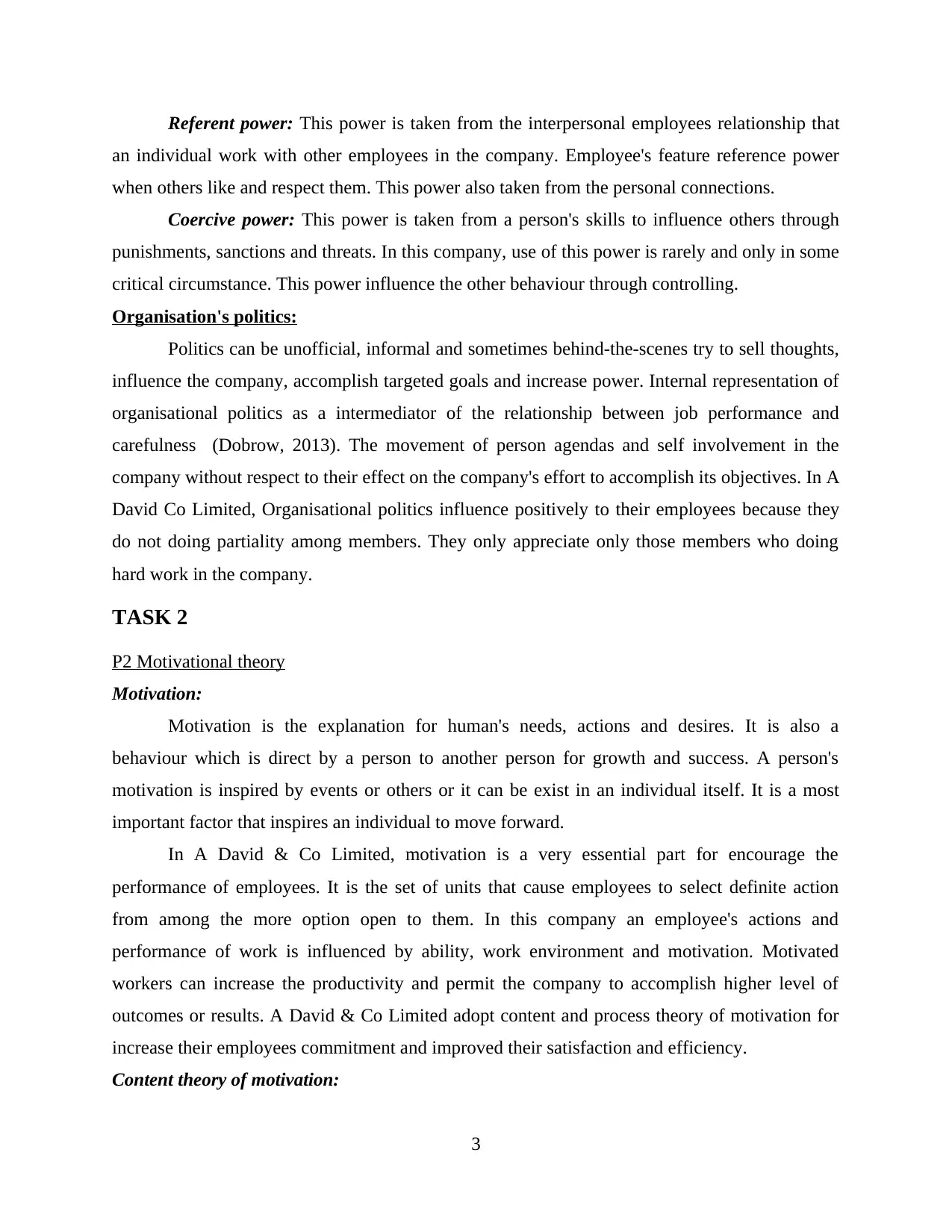
Referent power: This power is taken from the interpersonal employees relationship that
an individual work with other employees in the company. Employee's feature reference power
when others like and respect them. This power also taken from the personal connections.
Coercive power: This power is taken from a person's skills to influence others through
punishments, sanctions and threats. In this company, use of this power is rarely and only in some
critical circumstance. This power influence the other behaviour through controlling.
Organisation's politics:
Politics can be unofficial, informal and sometimes behind-the-scenes try to sell thoughts,
influence the company, accomplish targeted goals and increase power. Internal representation of
organisational politics as a intermediator of the relationship between job performance and
carefulness (Dobrow, 2013). The movement of person agendas and self involvement in the
company without respect to their effect on the company's effort to accomplish its objectives. In A
David Co Limited, Organisational politics influence positively to their employees because they
do not doing partiality among members. They only appreciate only those members who doing
hard work in the company.
TASK 2
P2 Motivational theory
Motivation:
Motivation is the explanation for human's needs, actions and desires. It is also a
behaviour which is direct by a person to another person for growth and success. A person's
motivation is inspired by events or others or it can be exist in an individual itself. It is a most
important factor that inspires an individual to move forward.
In A David & Co Limited, motivation is a very essential part for encourage the
performance of employees. It is the set of units that cause employees to select definite action
from among the more option open to them. In this company an employee's actions and
performance of work is influenced by ability, work environment and motivation. Motivated
workers can increase the productivity and permit the company to accomplish higher level of
outcomes or results. A David & Co Limited adopt content and process theory of motivation for
increase their employees commitment and improved their satisfaction and efficiency.
Content theory of motivation:
3
an individual work with other employees in the company. Employee's feature reference power
when others like and respect them. This power also taken from the personal connections.
Coercive power: This power is taken from a person's skills to influence others through
punishments, sanctions and threats. In this company, use of this power is rarely and only in some
critical circumstance. This power influence the other behaviour through controlling.
Organisation's politics:
Politics can be unofficial, informal and sometimes behind-the-scenes try to sell thoughts,
influence the company, accomplish targeted goals and increase power. Internal representation of
organisational politics as a intermediator of the relationship between job performance and
carefulness (Dobrow, 2013). The movement of person agendas and self involvement in the
company without respect to their effect on the company's effort to accomplish its objectives. In A
David Co Limited, Organisational politics influence positively to their employees because they
do not doing partiality among members. They only appreciate only those members who doing
hard work in the company.
TASK 2
P2 Motivational theory
Motivation:
Motivation is the explanation for human's needs, actions and desires. It is also a
behaviour which is direct by a person to another person for growth and success. A person's
motivation is inspired by events or others or it can be exist in an individual itself. It is a most
important factor that inspires an individual to move forward.
In A David & Co Limited, motivation is a very essential part for encourage the
performance of employees. It is the set of units that cause employees to select definite action
from among the more option open to them. In this company an employee's actions and
performance of work is influenced by ability, work environment and motivation. Motivated
workers can increase the productivity and permit the company to accomplish higher level of
outcomes or results. A David & Co Limited adopt content and process theory of motivation for
increase their employees commitment and improved their satisfaction and efficiency.
Content theory of motivation:
3
⊘ This is a preview!⊘
Do you want full access?
Subscribe today to unlock all pages.

Trusted by 1+ million students worldwide
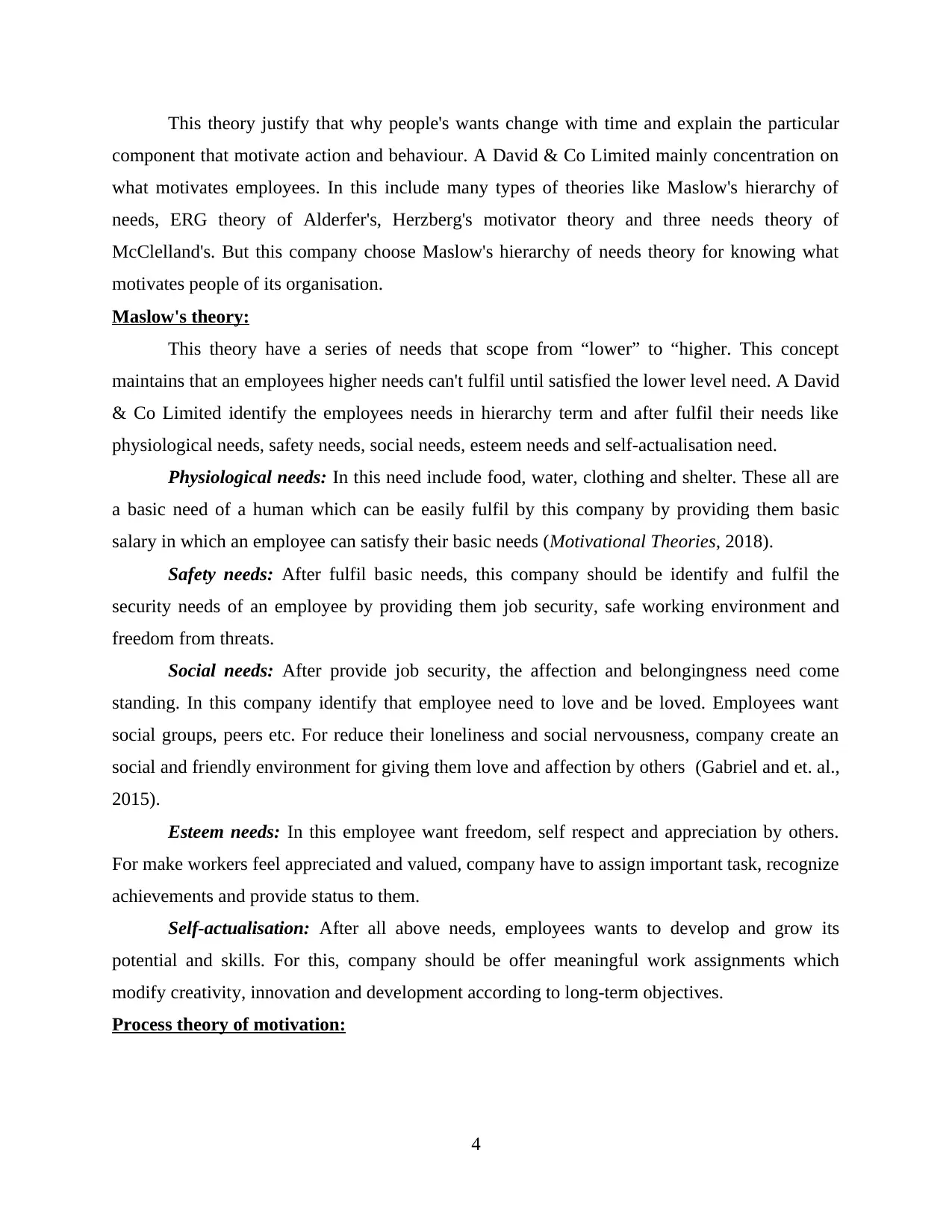
This theory justify that why people's wants change with time and explain the particular
component that motivate action and behaviour. A David & Co Limited mainly concentration on
what motivates employees. In this include many types of theories like Maslow's hierarchy of
needs, ERG theory of Alderfer's, Herzberg's motivator theory and three needs theory of
McClelland's. But this company choose Maslow's hierarchy of needs theory for knowing what
motivates people of its organisation.
Maslow's theory:
This theory have a series of needs that scope from “lower” to “higher. This concept
maintains that an employees higher needs can't fulfil until satisfied the lower level need. A David
& Co Limited identify the employees needs in hierarchy term and after fulfil their needs like
physiological needs, safety needs, social needs, esteem needs and self-actualisation need.
Physiological needs: In this need include food, water, clothing and shelter. These all are
a basic need of a human which can be easily fulfil by this company by providing them basic
salary in which an employee can satisfy their basic needs (Motivational Theories, 2018).
Safety needs: After fulfil basic needs, this company should be identify and fulfil the
security needs of an employee by providing them job security, safe working environment and
freedom from threats.
Social needs: After provide job security, the affection and belongingness need come
standing. In this company identify that employee need to love and be loved. Employees want
social groups, peers etc. For reduce their loneliness and social nervousness, company create an
social and friendly environment for giving them love and affection by others (Gabriel and et. al.,
2015).
Esteem needs: In this employee want freedom, self respect and appreciation by others.
For make workers feel appreciated and valued, company have to assign important task, recognize
achievements and provide status to them.
Self-actualisation: After all above needs, employees wants to develop and grow its
potential and skills. For this, company should be offer meaningful work assignments which
modify creativity, innovation and development according to long-term objectives.
Process theory of motivation:
4
component that motivate action and behaviour. A David & Co Limited mainly concentration on
what motivates employees. In this include many types of theories like Maslow's hierarchy of
needs, ERG theory of Alderfer's, Herzberg's motivator theory and three needs theory of
McClelland's. But this company choose Maslow's hierarchy of needs theory for knowing what
motivates people of its organisation.
Maslow's theory:
This theory have a series of needs that scope from “lower” to “higher. This concept
maintains that an employees higher needs can't fulfil until satisfied the lower level need. A David
& Co Limited identify the employees needs in hierarchy term and after fulfil their needs like
physiological needs, safety needs, social needs, esteem needs and self-actualisation need.
Physiological needs: In this need include food, water, clothing and shelter. These all are
a basic need of a human which can be easily fulfil by this company by providing them basic
salary in which an employee can satisfy their basic needs (Motivational Theories, 2018).
Safety needs: After fulfil basic needs, this company should be identify and fulfil the
security needs of an employee by providing them job security, safe working environment and
freedom from threats.
Social needs: After provide job security, the affection and belongingness need come
standing. In this company identify that employee need to love and be loved. Employees want
social groups, peers etc. For reduce their loneliness and social nervousness, company create an
social and friendly environment for giving them love and affection by others (Gabriel and et. al.,
2015).
Esteem needs: In this employee want freedom, self respect and appreciation by others.
For make workers feel appreciated and valued, company have to assign important task, recognize
achievements and provide status to them.
Self-actualisation: After all above needs, employees wants to develop and grow its
potential and skills. For this, company should be offer meaningful work assignments which
modify creativity, innovation and development according to long-term objectives.
Process theory of motivation:
4
Paraphrase This Document
Need a fresh take? Get an instant paraphrase of this document with our AI Paraphraser
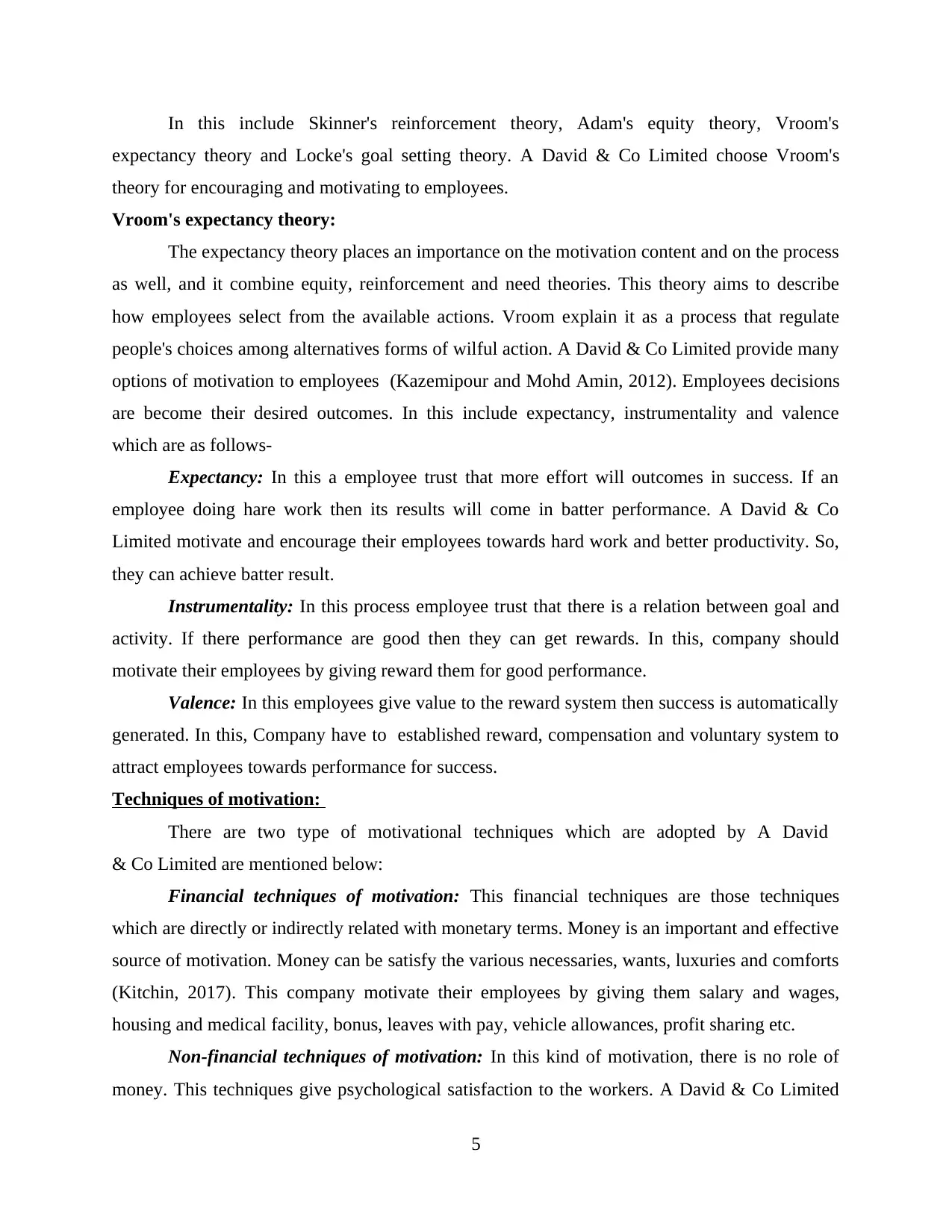
In this include Skinner's reinforcement theory, Adam's equity theory, Vroom's
expectancy theory and Locke's goal setting theory. A David & Co Limited choose Vroom's
theory for encouraging and motivating to employees.
Vroom's expectancy theory:
The expectancy theory places an importance on the motivation content and on the process
as well, and it combine equity, reinforcement and need theories. This theory aims to describe
how employees select from the available actions. Vroom explain it as a process that regulate
people's choices among alternatives forms of wilful action. A David & Co Limited provide many
options of motivation to employees (Kazemipour and Mohd Amin, 2012). Employees decisions
are become their desired outcomes. In this include expectancy, instrumentality and valence
which are as follows-
Expectancy: In this a employee trust that more effort will outcomes in success. If an
employee doing hare work then its results will come in batter performance. A David & Co
Limited motivate and encourage their employees towards hard work and better productivity. So,
they can achieve batter result.
Instrumentality: In this process employee trust that there is a relation between goal and
activity. If there performance are good then they can get rewards. In this, company should
motivate their employees by giving reward them for good performance.
Valence: In this employees give value to the reward system then success is automatically
generated. In this, Company have to established reward, compensation and voluntary system to
attract employees towards performance for success.
Techniques of motivation:
There are two type of motivational techniques which are adopted by A David
& Co Limited are mentioned below:
Financial techniques of motivation: This financial techniques are those techniques
which are directly or indirectly related with monetary terms. Money is an important and effective
source of motivation. Money can be satisfy the various necessaries, wants, luxuries and comforts
(Kitchin, 2017). This company motivate their employees by giving them salary and wages,
housing and medical facility, bonus, leaves with pay, vehicle allowances, profit sharing etc.
Non-financial techniques of motivation: In this kind of motivation, there is no role of
money. This techniques give psychological satisfaction to the workers. A David & Co Limited
5
expectancy theory and Locke's goal setting theory. A David & Co Limited choose Vroom's
theory for encouraging and motivating to employees.
Vroom's expectancy theory:
The expectancy theory places an importance on the motivation content and on the process
as well, and it combine equity, reinforcement and need theories. This theory aims to describe
how employees select from the available actions. Vroom explain it as a process that regulate
people's choices among alternatives forms of wilful action. A David & Co Limited provide many
options of motivation to employees (Kazemipour and Mohd Amin, 2012). Employees decisions
are become their desired outcomes. In this include expectancy, instrumentality and valence
which are as follows-
Expectancy: In this a employee trust that more effort will outcomes in success. If an
employee doing hare work then its results will come in batter performance. A David & Co
Limited motivate and encourage their employees towards hard work and better productivity. So,
they can achieve batter result.
Instrumentality: In this process employee trust that there is a relation between goal and
activity. If there performance are good then they can get rewards. In this, company should
motivate their employees by giving reward them for good performance.
Valence: In this employees give value to the reward system then success is automatically
generated. In this, Company have to established reward, compensation and voluntary system to
attract employees towards performance for success.
Techniques of motivation:
There are two type of motivational techniques which are adopted by A David
& Co Limited are mentioned below:
Financial techniques of motivation: This financial techniques are those techniques
which are directly or indirectly related with monetary terms. Money is an important and effective
source of motivation. Money can be satisfy the various necessaries, wants, luxuries and comforts
(Kitchin, 2017). This company motivate their employees by giving them salary and wages,
housing and medical facility, bonus, leaves with pay, vehicle allowances, profit sharing etc.
Non-financial techniques of motivation: In this kind of motivation, there is no role of
money. This techniques give psychological satisfaction to the workers. A David & Co Limited
5
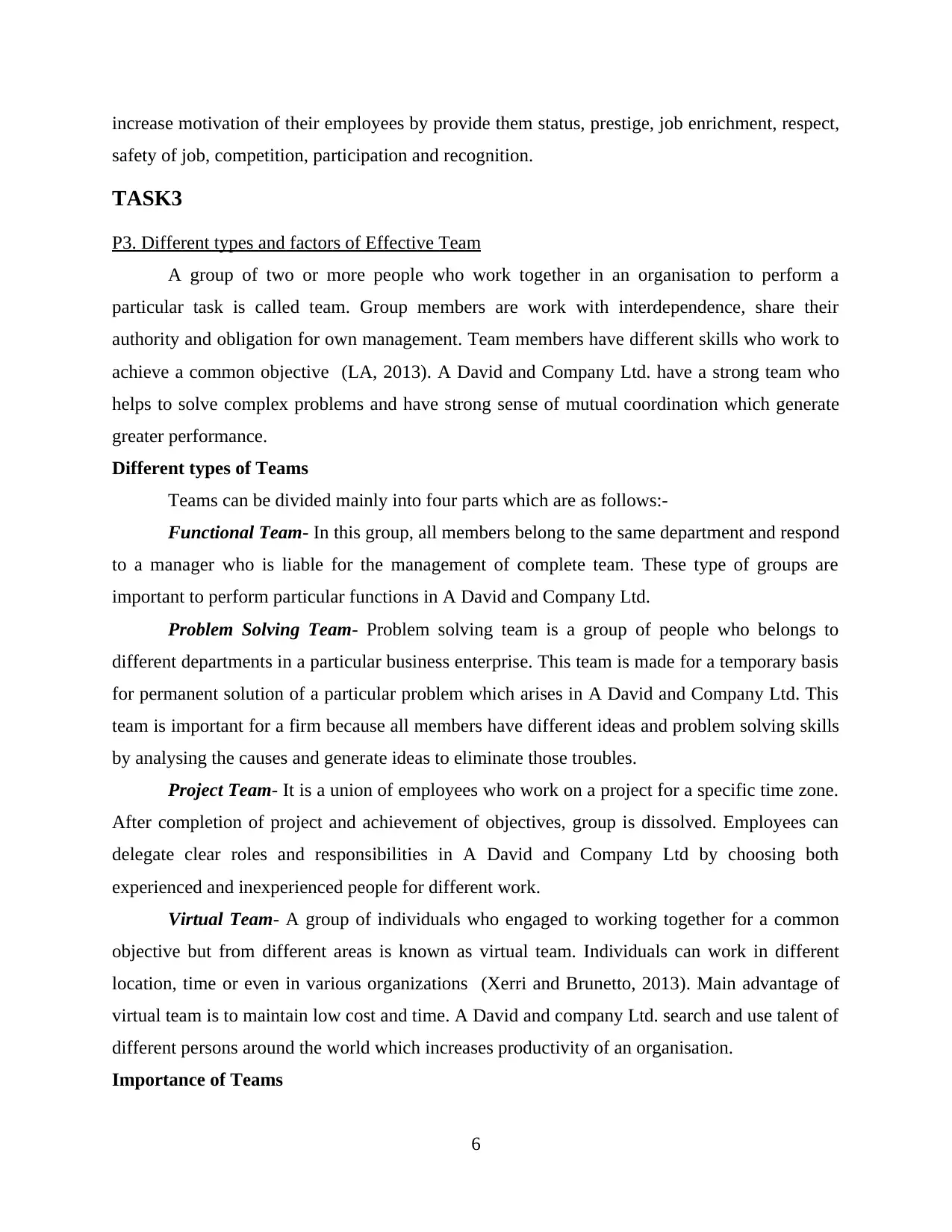
increase motivation of their employees by provide them status, prestige, job enrichment, respect,
safety of job, competition, participation and recognition.
TASK3
P3. Different types and factors of Effective Team
A group of two or more people who work together in an organisation to perform a
particular task is called team. Group members are work with interdependence, share their
authority and obligation for own management. Team members have different skills who work to
achieve a common objective (LA, 2013). A David and Company Ltd. have a strong team who
helps to solve complex problems and have strong sense of mutual coordination which generate
greater performance.
Different types of Teams
Teams can be divided mainly into four parts which are as follows:-
Functional Team- In this group, all members belong to the same department and respond
to a manager who is liable for the management of complete team. These type of groups are
important to perform particular functions in A David and Company Ltd.
Problem Solving Team- Problem solving team is a group of people who belongs to
different departments in a particular business enterprise. This team is made for a temporary basis
for permanent solution of a particular problem which arises in A David and Company Ltd. This
team is important for a firm because all members have different ideas and problem solving skills
by analysing the causes and generate ideas to eliminate those troubles.
Project Team- It is a union of employees who work on a project for a specific time zone.
After completion of project and achievement of objectives, group is dissolved. Employees can
delegate clear roles and responsibilities in A David and Company Ltd by choosing both
experienced and inexperienced people for different work.
Virtual Team- A group of individuals who engaged to working together for a common
objective but from different areas is known as virtual team. Individuals can work in different
location, time or even in various organizations (Xerri and Brunetto, 2013). Main advantage of
virtual team is to maintain low cost and time. A David and company Ltd. search and use talent of
different persons around the world which increases productivity of an organisation.
Importance of Teams
6
safety of job, competition, participation and recognition.
TASK3
P3. Different types and factors of Effective Team
A group of two or more people who work together in an organisation to perform a
particular task is called team. Group members are work with interdependence, share their
authority and obligation for own management. Team members have different skills who work to
achieve a common objective (LA, 2013). A David and Company Ltd. have a strong team who
helps to solve complex problems and have strong sense of mutual coordination which generate
greater performance.
Different types of Teams
Teams can be divided mainly into four parts which are as follows:-
Functional Team- In this group, all members belong to the same department and respond
to a manager who is liable for the management of complete team. These type of groups are
important to perform particular functions in A David and Company Ltd.
Problem Solving Team- Problem solving team is a group of people who belongs to
different departments in a particular business enterprise. This team is made for a temporary basis
for permanent solution of a particular problem which arises in A David and Company Ltd. This
team is important for a firm because all members have different ideas and problem solving skills
by analysing the causes and generate ideas to eliminate those troubles.
Project Team- It is a union of employees who work on a project for a specific time zone.
After completion of project and achievement of objectives, group is dissolved. Employees can
delegate clear roles and responsibilities in A David and Company Ltd by choosing both
experienced and inexperienced people for different work.
Virtual Team- A group of individuals who engaged to working together for a common
objective but from different areas is known as virtual team. Individuals can work in different
location, time or even in various organizations (Xerri and Brunetto, 2013). Main advantage of
virtual team is to maintain low cost and time. A David and company Ltd. search and use talent of
different persons around the world which increases productivity of an organisation.
Importance of Teams
6
⊘ This is a preview!⊘
Do you want full access?
Subscribe today to unlock all pages.

Trusted by 1+ million students worldwide
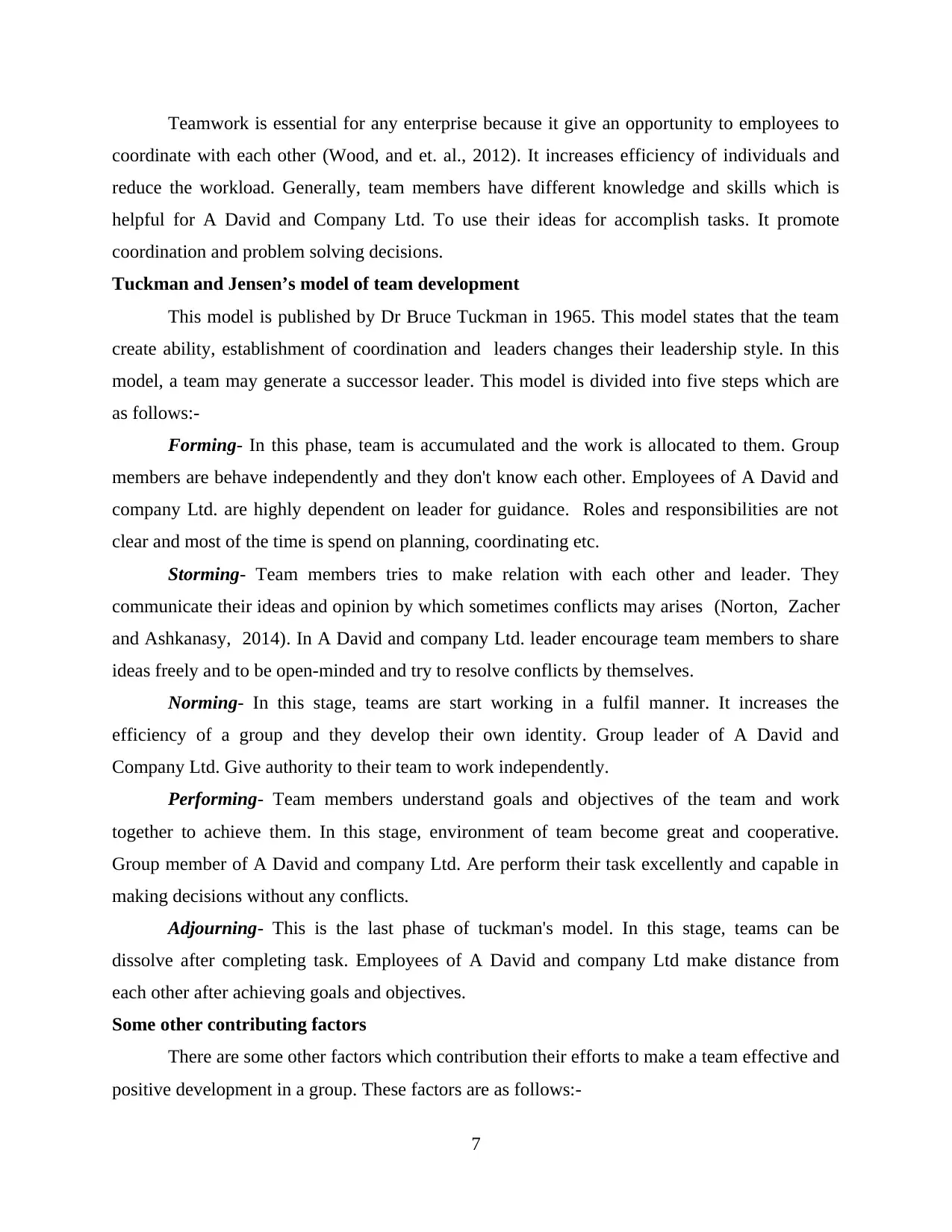
Teamwork is essential for any enterprise because it give an opportunity to employees to
coordinate with each other (Wood, and et. al., 2012). It increases efficiency of individuals and
reduce the workload. Generally, team members have different knowledge and skills which is
helpful for A David and Company Ltd. To use their ideas for accomplish tasks. It promote
coordination and problem solving decisions.
Tuckman and Jensen’s model of team development
This model is published by Dr Bruce Tuckman in 1965. This model states that the team
create ability, establishment of coordination and leaders changes their leadership style. In this
model, a team may generate a successor leader. This model is divided into five steps which are
as follows:-
Forming- In this phase, team is accumulated and the work is allocated to them. Group
members are behave independently and they don't know each other. Employees of A David and
company Ltd. are highly dependent on leader for guidance. Roles and responsibilities are not
clear and most of the time is spend on planning, coordinating etc.
Storming- Team members tries to make relation with each other and leader. They
communicate their ideas and opinion by which sometimes conflicts may arises (Norton, Zacher
and Ashkanasy, 2014). In A David and company Ltd. leader encourage team members to share
ideas freely and to be open-minded and try to resolve conflicts by themselves.
Norming- In this stage, teams are start working in a fulfil manner. It increases the
efficiency of a group and they develop their own identity. Group leader of A David and
Company Ltd. Give authority to their team to work independently.
Performing- Team members understand goals and objectives of the team and work
together to achieve them. In this stage, environment of team become great and cooperative.
Group member of A David and company Ltd. Are perform their task excellently and capable in
making decisions without any conflicts.
Adjourning- This is the last phase of tuckman's model. In this stage, teams can be
dissolve after completing task. Employees of A David and company Ltd make distance from
each other after achieving goals and objectives.
Some other contributing factors
There are some other factors which contribution their efforts to make a team effective and
positive development in a group. These factors are as follows:-
7
coordinate with each other (Wood, and et. al., 2012). It increases efficiency of individuals and
reduce the workload. Generally, team members have different knowledge and skills which is
helpful for A David and Company Ltd. To use their ideas for accomplish tasks. It promote
coordination and problem solving decisions.
Tuckman and Jensen’s model of team development
This model is published by Dr Bruce Tuckman in 1965. This model states that the team
create ability, establishment of coordination and leaders changes their leadership style. In this
model, a team may generate a successor leader. This model is divided into five steps which are
as follows:-
Forming- In this phase, team is accumulated and the work is allocated to them. Group
members are behave independently and they don't know each other. Employees of A David and
company Ltd. are highly dependent on leader for guidance. Roles and responsibilities are not
clear and most of the time is spend on planning, coordinating etc.
Storming- Team members tries to make relation with each other and leader. They
communicate their ideas and opinion by which sometimes conflicts may arises (Norton, Zacher
and Ashkanasy, 2014). In A David and company Ltd. leader encourage team members to share
ideas freely and to be open-minded and try to resolve conflicts by themselves.
Norming- In this stage, teams are start working in a fulfil manner. It increases the
efficiency of a group and they develop their own identity. Group leader of A David and
Company Ltd. Give authority to their team to work independently.
Performing- Team members understand goals and objectives of the team and work
together to achieve them. In this stage, environment of team become great and cooperative.
Group member of A David and company Ltd. Are perform their task excellently and capable in
making decisions without any conflicts.
Adjourning- This is the last phase of tuckman's model. In this stage, teams can be
dissolve after completing task. Employees of A David and company Ltd make distance from
each other after achieving goals and objectives.
Some other contributing factors
There are some other factors which contribution their efforts to make a team effective and
positive development in a group. These factors are as follows:-
7
Paraphrase This Document
Need a fresh take? Get an instant paraphrase of this document with our AI Paraphraser
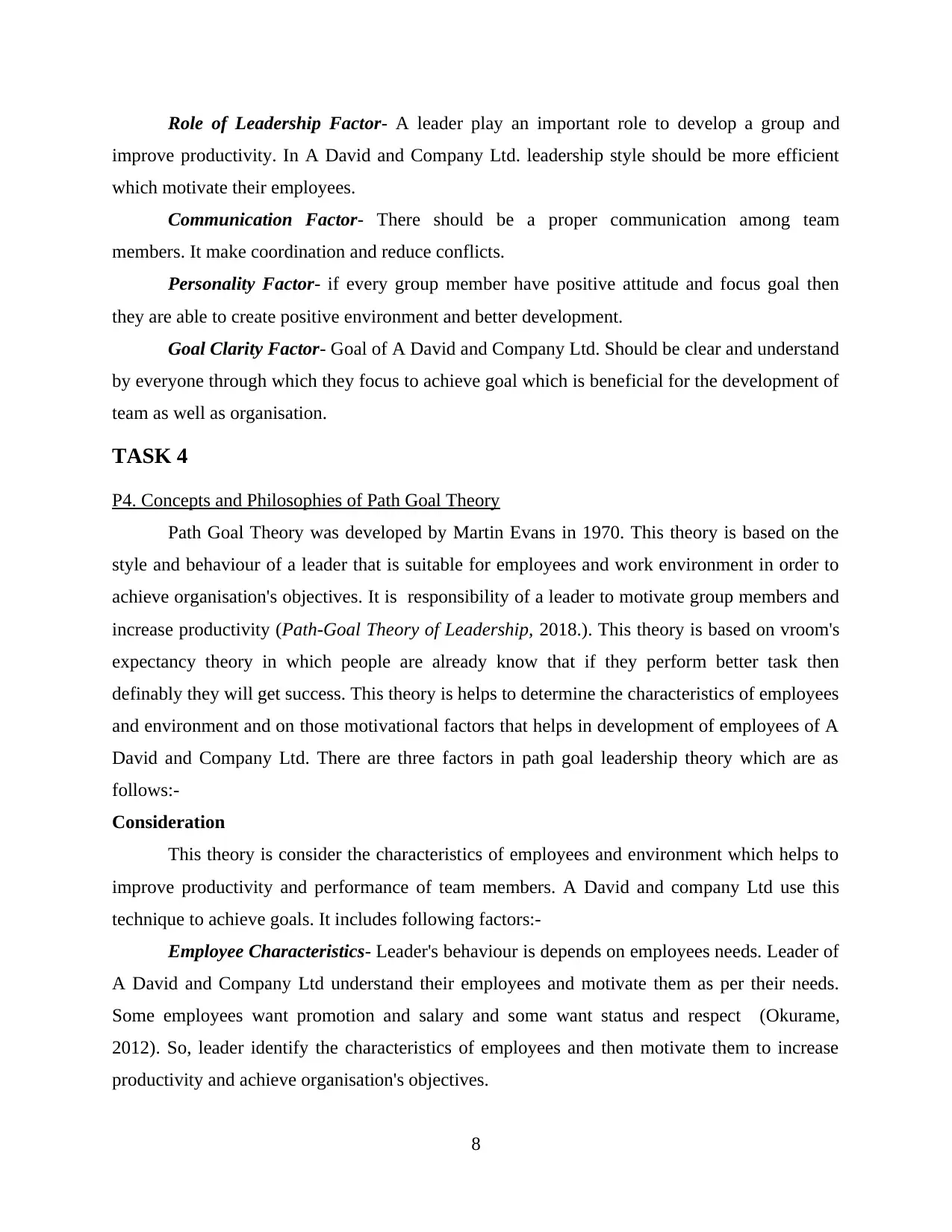
Role of Leadership Factor- A leader play an important role to develop a group and
improve productivity. In A David and Company Ltd. leadership style should be more efficient
which motivate their employees.
Communication Factor- There should be a proper communication among team
members. It make coordination and reduce conflicts.
Personality Factor- if every group member have positive attitude and focus goal then
they are able to create positive environment and better development.
Goal Clarity Factor- Goal of A David and Company Ltd. Should be clear and understand
by everyone through which they focus to achieve goal which is beneficial for the development of
team as well as organisation.
TASK 4
P4. Concepts and Philosophies of Path Goal Theory
Path Goal Theory was developed by Martin Evans in 1970. This theory is based on the
style and behaviour of a leader that is suitable for employees and work environment in order to
achieve organisation's objectives. It is responsibility of a leader to motivate group members and
increase productivity (Path-Goal Theory of Leadership, 2018.). This theory is based on vroom's
expectancy theory in which people are already know that if they perform better task then
definably they will get success. This theory is helps to determine the characteristics of employees
and environment and on those motivational factors that helps in development of employees of A
David and Company Ltd. There are three factors in path goal leadership theory which are as
follows:-
Consideration
This theory is consider the characteristics of employees and environment which helps to
improve productivity and performance of team members. A David and company Ltd use this
technique to achieve goals. It includes following factors:-
Employee Characteristics- Leader's behaviour is depends on employees needs. Leader of
A David and Company Ltd understand their employees and motivate them as per their needs.
Some employees want promotion and salary and some want status and respect (Okurame,
2012). So, leader identify the characteristics of employees and then motivate them to increase
productivity and achieve organisation's objectives.
8
improve productivity. In A David and Company Ltd. leadership style should be more efficient
which motivate their employees.
Communication Factor- There should be a proper communication among team
members. It make coordination and reduce conflicts.
Personality Factor- if every group member have positive attitude and focus goal then
they are able to create positive environment and better development.
Goal Clarity Factor- Goal of A David and Company Ltd. Should be clear and understand
by everyone through which they focus to achieve goal which is beneficial for the development of
team as well as organisation.
TASK 4
P4. Concepts and Philosophies of Path Goal Theory
Path Goal Theory was developed by Martin Evans in 1970. This theory is based on the
style and behaviour of a leader that is suitable for employees and work environment in order to
achieve organisation's objectives. It is responsibility of a leader to motivate group members and
increase productivity (Path-Goal Theory of Leadership, 2018.). This theory is based on vroom's
expectancy theory in which people are already know that if they perform better task then
definably they will get success. This theory is helps to determine the characteristics of employees
and environment and on those motivational factors that helps in development of employees of A
David and Company Ltd. There are three factors in path goal leadership theory which are as
follows:-
Consideration
This theory is consider the characteristics of employees and environment which helps to
improve productivity and performance of team members. A David and company Ltd use this
technique to achieve goals. It includes following factors:-
Employee Characteristics- Leader's behaviour is depends on employees needs. Leader of
A David and Company Ltd understand their employees and motivate them as per their needs.
Some employees want promotion and salary and some want status and respect (Okurame,
2012). So, leader identify the characteristics of employees and then motivate them to increase
productivity and achieve organisation's objectives.
8
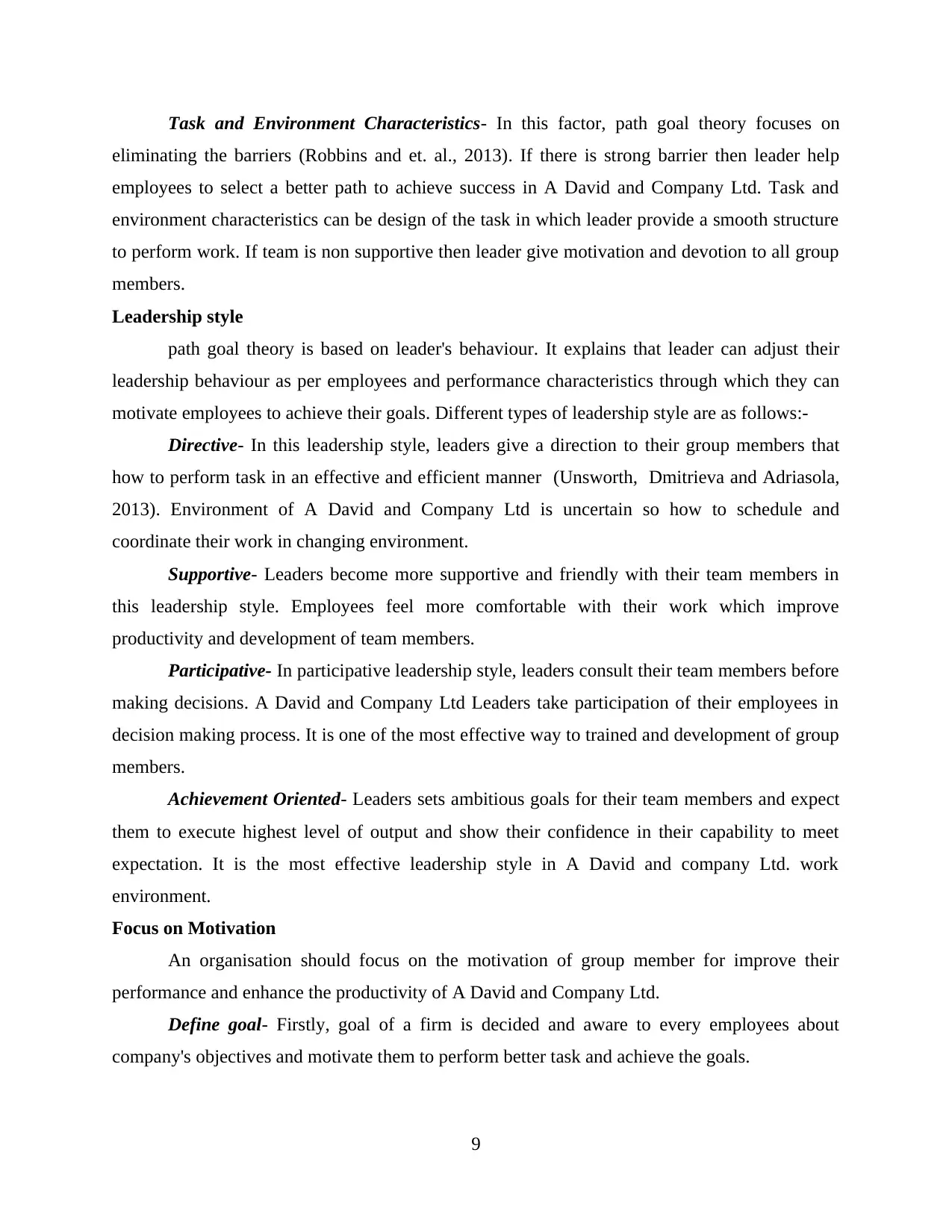
Task and Environment Characteristics- In this factor, path goal theory focuses on
eliminating the barriers (Robbins and et. al., 2013). If there is strong barrier then leader help
employees to select a better path to achieve success in A David and Company Ltd. Task and
environment characteristics can be design of the task in which leader provide a smooth structure
to perform work. If team is non supportive then leader give motivation and devotion to all group
members.
Leadership style
path goal theory is based on leader's behaviour. It explains that leader can adjust their
leadership behaviour as per employees and performance characteristics through which they can
motivate employees to achieve their goals. Different types of leadership style are as follows:-
Directive- In this leadership style, leaders give a direction to their group members that
how to perform task in an effective and efficient manner (Unsworth, Dmitrieva and Adriasola,
2013). Environment of A David and Company Ltd is uncertain so how to schedule and
coordinate their work in changing environment.
Supportive- Leaders become more supportive and friendly with their team members in
this leadership style. Employees feel more comfortable with their work which improve
productivity and development of team members.
Participative- In participative leadership style, leaders consult their team members before
making decisions. A David and Company Ltd Leaders take participation of their employees in
decision making process. It is one of the most effective way to trained and development of group
members.
Achievement Oriented- Leaders sets ambitious goals for their team members and expect
them to execute highest level of output and show their confidence in their capability to meet
expectation. It is the most effective leadership style in A David and company Ltd. work
environment.
Focus on Motivation
An organisation should focus on the motivation of group member for improve their
performance and enhance the productivity of A David and Company Ltd.
Define goal- Firstly, goal of a firm is decided and aware to every employees about
company's objectives and motivate them to perform better task and achieve the goals.
9
eliminating the barriers (Robbins and et. al., 2013). If there is strong barrier then leader help
employees to select a better path to achieve success in A David and Company Ltd. Task and
environment characteristics can be design of the task in which leader provide a smooth structure
to perform work. If team is non supportive then leader give motivation and devotion to all group
members.
Leadership style
path goal theory is based on leader's behaviour. It explains that leader can adjust their
leadership behaviour as per employees and performance characteristics through which they can
motivate employees to achieve their goals. Different types of leadership style are as follows:-
Directive- In this leadership style, leaders give a direction to their group members that
how to perform task in an effective and efficient manner (Unsworth, Dmitrieva and Adriasola,
2013). Environment of A David and Company Ltd is uncertain so how to schedule and
coordinate their work in changing environment.
Supportive- Leaders become more supportive and friendly with their team members in
this leadership style. Employees feel more comfortable with their work which improve
productivity and development of team members.
Participative- In participative leadership style, leaders consult their team members before
making decisions. A David and Company Ltd Leaders take participation of their employees in
decision making process. It is one of the most effective way to trained and development of group
members.
Achievement Oriented- Leaders sets ambitious goals for their team members and expect
them to execute highest level of output and show their confidence in their capability to meet
expectation. It is the most effective leadership style in A David and company Ltd. work
environment.
Focus on Motivation
An organisation should focus on the motivation of group member for improve their
performance and enhance the productivity of A David and Company Ltd.
Define goal- Firstly, goal of a firm is decided and aware to every employees about
company's objectives and motivate them to perform better task and achieve the goals.
9
⊘ This is a preview!⊘
Do you want full access?
Subscribe today to unlock all pages.

Trusted by 1+ million students worldwide
1 out of 16
Related Documents
Your All-in-One AI-Powered Toolkit for Academic Success.
+13062052269
info@desklib.com
Available 24*7 on WhatsApp / Email
![[object Object]](/_next/static/media/star-bottom.7253800d.svg)
Unlock your academic potential
Copyright © 2020–2025 A2Z Services. All Rights Reserved. Developed and managed by ZUCOL.





